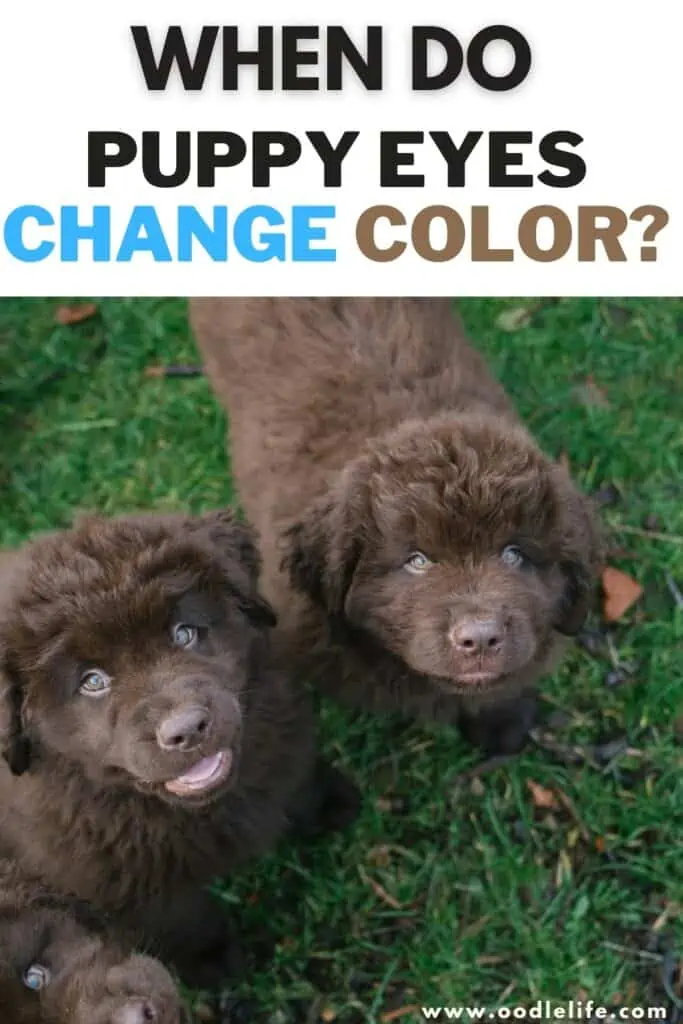Have you ever gazed into the mesmerizing blue eyes of a newborn puppy and wondered if they’ll stay that color forever? It’s a question that has puzzled dog lovers for generations. After all, those baby blues are often the first glimpse into a puppy’s personality, and the thought of them changing is almost bittersweet. The truth is, those bright blue eyes are often a temporary phase, a fleeting moment in a puppy’s evolution. But why? And how does it happen? Let’s delve into the fascinating world of puppy eye color, uncovering the science behind this captivating transformation.

Image: pawsafe.com
The change in a puppy’s eye color, or “eye pigment,” is a captivating journey that reveals the intricate workings of genetics and development. It’s not just a whimsical shift; it’s an essential part of a puppy’s maturation. Understanding these changes allows us to appreciate the subtle beauty of canine development and offers insight into the unique inheritance patterns that define each individual pup.
The Science of Puppy Eye Color
The color of a puppy’s eyes is determined by the amount of melanin, a pigment, present in the iris, the colored part of the eye. As a puppy develops, the iris produces more melanin, leading to a gradual change in eye color. The absence of melanin results in blue eyes, while higher levels of melanin produce darker hues like brown, amber, or even green.
The Timeline of Transformation
Typically, a puppy’s eye color begins as a bright blue, a reflection of the underdeveloped iris. This blue hue is often seen in newborn puppies, sometimes lasting for only a few weeks. However, the real transformation begins around 6 to 8 weeks of age.
The First Clues
As a puppy grows, melanin starts accumulating in the iris, leading to subtle shifts in eye color. You might notice a change from a bright blue to a hazy, less vibrant blue. Sometimes, these subtle changes can be difficult to detect, making the final color a surprise even for experienced breeders.

Image: www.oodlelife.com
The Final Shift
At 10 to 12 weeks, the final eye color is usually apparent. While the exact timeline might vary slightly depending on the breed, it’s generally during this period that the iris has produced enough melanin to establish the mature eye shade. It’s important to remember that there are always exceptions, and occasionally a puppy’s eye color might continue to change subtly until even 16 weeks of age.
Why Do Eye Colors Change?
The change in eye color is a natural process, influenced by the complex interplay of genetics and development. Here’s a breakdown of the key factors:
Genetics: A Family Affair
The first and foremost factor is the puppy’s inheritance. Eye color is a trait determined by genes inherited from both parents. The genes responsible for eye color produce specific proteins, influencing the amount of melanin produced in the iris. Some breeds are known for producing certain eye colors more often, for example, the Siberian Husky is typically known for its captivating blue eyes. Other breeds like the Labrador Retriever offer a wider range of eye colors, including brown, amber, and even green.
Development: A Gradual Process
The production of melanin is not instantaneous. It’s a gradual process, influenced by factors like diet and overall health. As the puppy grows and matures, the iris cells become more efficient at producing melanin, leading to noticeable changes in eye color. The process isn’t always predictable, and some puppies might witness slower or more dramatic changes than others.
Environment: Subtle Influences
While not as dominant as genetics and development, the environment can play a minor role. Factors like exposure to sunlight, diet, and overall health can impact the production and distribution of melanin in the iris. For example, puppies fed a diet rich in protein and essential nutrients may experience more prominent changes in eye color due to enhanced growth and development.
The Mystery of Heterochromia
A rare but fascinating phenomenon, heterochromia, occurs when a puppy has different colored eyes. This occurs when the irises, usually one blue and the other brown or amber, have different levels of melanin. Heterochromia can occur due to genetic factors, often present in breeds like the Australian Shepherd, or even as a result of injury or disease. While eye color variations are often beautiful and add to the individuality of a dog, if you notice any sudden eye color changes, it’s essential to consult a veterinarian to rule out any underlying health concerns.
Beyond Eye Color: A Window into Health
The changing eye color in puppies isn’t just an aesthetic phenomenon; it can also be an indicator of overall health. While most eye color changes are normal developmental processes, if you notice any rapid or unusual shifts, especially accompanied by other symptoms like lethargy, discharge, or squinting, it’s crucial to seek veterinary attention. These symptoms can be signs of underlying health issues that need prompt diagnosis and treatment.
When Does A Puppies Eyes Change Color
https://youtube.com/watch?v=MCG3cTBKTIY
Conclusion: A Glimpse into a Puppy’s Journey
The change in a puppy’s eye color is a captivating journey, a testament to the intricate interplay of genetics, development, and environment. It’s a reminder that even seemingly simple physical traits are often the result of complex biological processes. While the blue eyes of a newborn puppy might evoke a sense of wonder, the eventual shift to other shades reveals the unique path each puppy takes to adulthood. So, if you’re lucky enough to witness this transformation firsthand, cherish it as a testament to the beauty and complexity of canine development. And remember, if you have any concerns, consult your veterinarian for guidance.






